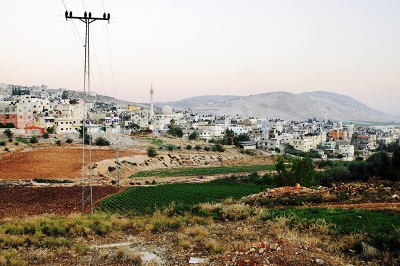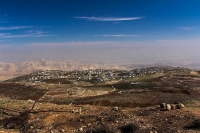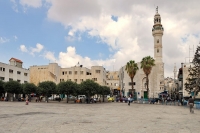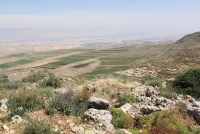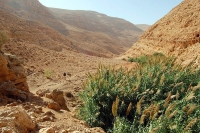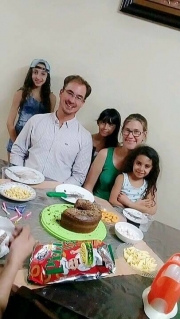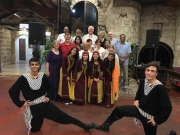Jericho is located in the eastern West Bank, near the Jordan River. A city of great religious and historical importance, Jericho is believed to have been inhabited for over 11,000 years, making it one of the oldest inhabited cities in the world. The protective wall encompassing it is the oldest of its kind. In the Torah, Jericho is described as the “City of Palm Trees”, and its continuous inhabitation is in large part due to the plethora of natural springs in and around the city. The earliest settlement in the area was located a couple of kilometers away from modern Jericho at a site called Tel as-Sultan (Sultan’s Hill). At 250 meters below sea level, Tel as-Sultan is not only the oldest but also the lowest town on earth.
Located in the northern West Bank, Jenin is the administrative center of the Jenin Governorate. Jenin is situated on the edge of the Jezreel Valley, 1.5 kilometers west of Mount Gilboa and 43 kilometers north of Nablus. The city’s name derives from the Arabic ‘Ain Ganim’, meaning the ‘Spring of Ganim’, and the area is known for its agriculture, particularly its carob, fig and palm trees.
At a crossroads between the sea and the northern and eastern regions, Jenin was a town of significant importance to the Crusaders. Saladin captured it in 1187, and in the 13th century the Mamluks added fortification to the old city in an attempt to protect from further Crusader attacks. Jenin came under Jordanian control in 1948 before being occupied by Israel in 1967. Jenin is home to a refugee camp of over 10,000 displaced persons, established in 1953 by the Jordanians to shelter thousands of Palestinians who fled or were forcibly removed from their land in 1948. Home to a majority Muslim population, the city has been under the control of the Palestinian National Authority since 1996.
Overnight
|
Type of Accommodation |
Hotel |
|
Name |
North Gate Hotel, Haddad Resort Village |
|
Website |
Notes
In villages it is important that you are dressed modestly at all times: this means wearing loose, opaque clothing that covers the shoulders and knees. Women should carry a lightweight scarf with which they can cover themselves when entering mosques or other holy sites.
Due to its Muslim population you will not be able to find alcohol in Jenin, except for in the Haddad Resort Village.
While well-stocked pharmacies are easily accessible in much of the West Bank, you might not be able to find some desired medicines in small villages. For this reason, we recommend that you bring with you high SPF sunscreen, aspirin or other pain relievers, antihistamine, disinfectant, insect repellent, antibiotics and intestinal antiseptics. You should also have a hat, water bottle, backpack and comfortable shoes with you at all times to ensure your health and comfort while walking.
Far’a is a Palestinian refugee camp in the northwestern West Bank. Located in the Wadi of Patriarchs in the foothills of the Jordan Valley, 2 kilometers south of Tubas and 3 kilometers northwest of Tammun, Far’a is named for the nearby Far’a spring from which it gets its water. Visitors to Far’a area can see the archeological site of Tirza, which contains the ruins of a tower from the Crusaders period, as well as a former British prison that became a youth center following the 1993 Oslo Accords.
Faqu’a is located on the Green Line in the northern West Bank, 11 kilometers east of Jenin. Located on the Gilboa ridge, Faqu’a overlooks the Jordan River Valley to the east and the Jezreel Valley to the west. The town has a Roman and Byzantine history, evidenced by the coins and pottery shards found in the area, and visitors can find several cisterns carved into nearby rock. Faqu’a is famous for its cactus fruit, although agricultural production has been disrupted by water shortages in recent years.
Notes
We will stop in Faqu’a for lunch with a Bedouin family. In villages it is important that you are dressed modestly at all times: this means wearing loose, opaque clothing that covers the shoulders and knees. Women should carry a lightweight scarf with which they can cover themselves when entering mosques or other holy sites.
Duma is a Palestinian town located in the northern West Bank, 25 kilometers southeast of the city of Nablus. Rich in history, pieces of pottery from the Hellenistic and Roman eras have been found there. Duma came under Jordanian rule in 1949 before being occupied by the Israelis following the Six-Day War of 1967.
Located in the central West Bank just 6 kilometers south of Jerusalem, Bethlehem is a Palestinian city home to about 25,000 people. Pilgrims from around the world come to see the place where, according to the New Testament, Jesus was born. According to the Torah David was also from Bethlehem, and it was here that he was proclaimed the King of Israel. Bethlehem was destroyed in the second century by the forces of Emperor Hadrian, but was rebuilt under the instruction of Empress Helena, the mother of Constantine. Constantine and Helena ordered the construction of the Church of the Nativity in 327 CE on the site where Jesus was said to have been born. The church was badly damaged by a Samaritan revolt in 529, but Emperor Justinian oversaw its repair nearly a century later. Bethlehem was taken in the Rashidun conquests of 637 before being conquered by the Crusaders in 1099. It has been under the control of the Palestinian National Authority since the 1995 Oslo Accords.
Located in the northern West Bank just 18 kilometers southeast of Nablus, Aqraba is a town of approximately 9,000 residents. Roughly 60% of the uninhabited land is used for almond and olive cultivation, with the remaining 40% being used for fruits, vegetables and grazing purposes.
Located in the Jericho Governorate in the eastern West Bank, Al Auja is a Palestinian town 230 meters below sea level and just ten kilometers north from Jericho itself. The total area of the town is about 108 square kilometers (107,905 dunams), although of that only about 1 kilometer (832 dunams) has been built upon. Of the rest of the area, over 10% is used for agriculture: Al Auja is known for its bananas, oranges, dates and vegetables that are irrigated from the Al Auja spring. Al Auja, meaning ‘meandering one,’ is named for the Wadi al-Auja stream that runs alongside it.
More...
Network of Experiential Palestinian Tourism Organizations www.NEPTO.ps
Palestinian Initiative for Responsible Tourism www.pirt.ps
Masar Ibrahim Alkhalil “Abraham Path “Palestine www.masaribrahim.ps
Applied Research Institute – Jerusalem www.arij.org
Holy Land Handicraft cooperate Society www.hlhcs.org
Israelis Community Against House demolishing www.icahd.org
Palestine Museum of Natural History www.palestinenature.org
Paltrips www.paltrips.ps
The Switchers www.theswitchers.eu/en
A Visit to Em Shadi Guesthouse in Duma
“Welcome! Our Home is Your Home!”
Em Shadi (“Mother of Shadi” in Arabic) is always eager to greet her guests to her home in Duma, a tranquil agricultural village in southeastern Nablus district. Em Shadi is a passionate believer in volunteer work. In the past she served as a director for a Women’s Association in Duma, and has also served on the Duma village council for six years. A wife and a proud mother of six children, she strives for women empowerment in all that she does.
Summer Homestay Students Jonas and Karin Report In
Dear Siraj Team,
We are enjoying to stay in a family while learning spoken Arabic at Bethlehem University. For us the stay in a family increases our possibility to learn Arabic, and also to better understand how an ordinary life can be here.
The day to day conversations and interactions with family members challenges us to speak the language.
The outstanding service with meals served at breakfast and dinner gives us more time to study which is well-needed.
Yours sincerely,
Jonas and Karin Bodin
The Siraj Center Is Palestine
Veteran program leader Paul Parker returns with an Abraham’s Children program
In 2005 I took a summer Arabic language course from Birzeit University with dozens of other internationals during which Michel Awad and George S. Rishmawi arranged several weekend explorations of Palestinian culture and traditions. I was immediately impressed with their professionalism and internationalism while remaining deeply rooted in the Palestinian reality. The Siraj Center is Palestine. As a university professor who has now led ten public, non-profit tours to introduce North Americans to Palestine, I highly recommend the Siraj Center to university students for summer courses, to families for alternative vacations, to Muslim and Christian pilgrims, and to those who are looking for an adventure. Biking, hiking, dancing, learning Arabic, guided tours, home-stays, religious pilgrimages, and fact-finding delegations—the Siraj Center provides safe, expert and ethical tourist arrangements.
- Paul Parker



